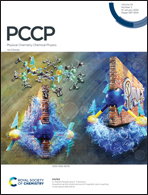Molecular basis of the activation and dissociation of dimeric PYL2 receptor in abscisic acid signaling†
Abstract
Phytohormone abscisic acid (ABA) is essential for plant responses to biotic and abiotic stresses. Dimeric receptors are a class of PYR1/PYL/RCAR (pyrabactin resistance 1/PYR1-like/regulatory component of ABA receptors) ABA receptors that are important for various ABA responses. While extensive experimental and computational studies have investigated these receptors, it remains not fully understood how ABA leads to their activation and dissociation for interaction with downstream protein phosphatase 2C (PP2C). Here, we study the activation and the homodimeric association processes of the PYL2 receptor as well as its heterodimeric association with protein phosphatase 2C 16 (HAB1) using molecular dynamics simulations. Free energy landscapes from ∼223 μs simulations show that dimerization substantially constrains PYL2 conformational plasticity and stabilizes the inactive state, resulting in lower ABA affinity. Also, we establish the thermodynamic model for competitive binding between homodimeric PYL2 association and heterodimeric PYL2–HAB1 association in the absence and presence of ABA. Our results suggest that the binding of ABA destabilizes the PYL2 complex and further stabilizes PYL2–HAB1 association, thereby promoting PYL2 dissociation. Overall, this study explains several key aspects on the activation of dimeric ABA receptors, which provide new avenues for selective regulation of these receptors.



 Please wait while we load your content...
Please wait while we load your content...